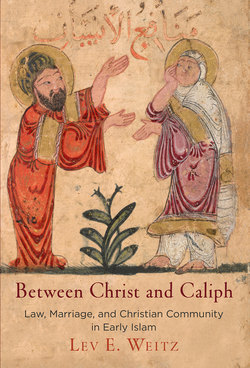Between Christ and Caliph

Реклама. ООО «ЛитРес», ИНН: 7719571260.
Оглавление
Lev E. Weitz. Between Christ and Caliph
Отрывок из книги
Between Christ and Caliph
SERIES EDITORS
.....
While Muslims ruled over many other Christians outside the Fertile Crescent and Iran, transformations to Christian law, the household, and the religious community in the early medieval period took place especially in the core territories of the Umayyad and Abbasid caliphates. We will consider the history of other Christian groups, especially the Copts of Egypt, for comparative purposes at times, but they will remain largely outside the scope of this study.
From the sixth century to the tenth, the Christian communities of the Middle East underwent an array of transformations related to connections among the household, religious affiliation, and imperial rule. In the Islamic caliphate in the latter centuries of this period, increasingly intensive interactions between Christian elites and Islamic institutions spurred the former to reimagine the nature of Christian communities within caliphal society. Part I of this book traces the overall arc of these developments. Chapter 1 sets the backdrop by examining marriage and Christian canon law in the late antique Roman and Sasanian empires, arguing that in both realms ecclesiastical attempts to reform lay sexual practices ran up against enduring civil law traditions that defined marriage as a social institution. The seventh century and the early decades of the Umayyad Caliphate, by contrast, show evidence of the beginnings of a shift, which Chapter 2 explores. Regulating marriage became an increasingly prominent part of Christian bishops’ efforts to define communal boundaries amid the fluid socioreligious and institutional conditions brought on by the fall of the old empires and the introduction of a new ruling religion. In response to apostasy to Islam and intermarriage with the conquerors, bishops asserted for the first time the exclusive authority of ecclesiastical law, rather than civil, tribal, or local custom, to govern marriages between Christians. These Umayyad-era transformations developed into the great elaboration of Christian communal law in the central lands of the Abbasid Caliphate from the late eighth century through the ninth, the fulcrum of the book’s narrative and the subject of Chapter 3. In response to new caliphal institutions of governance and the emergence of robust traditions of Islamic law, ecclesiastics in the Abbasid heartlands made newly comprehensive efforts to define communal boundaries through confessional law. Above all else, they focused on regulating the full range of marital and inheritance practices that facilitated the social reproduction of households and lineages. Christian law thus reformulated the household as a Christian institution not only in theological terms but in its material and social constitution; and it established the link between ecclesiastical legal authority and lay households as the defining feature of Christians as social collectivities within the caliphate.
.....